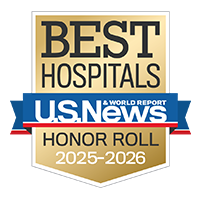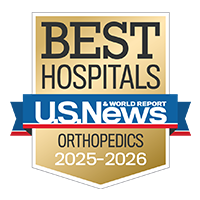Knee Cartilage Injury

Overview
Articular cartilage is a firm, rubbery tissue covering the ends of bones in joints, such as the knee and hip. It reduces friction in the joint and provides shock absorption. In the knee, damaged or deteriorated cartilage limits the joint’s normal movement and can cause significant pain. If the problem isn’t treated, it can worsen and eventually require knee replacement surgery.
Our Approach to Knee Cartilage Injuries
UCSF offers world-class care for both simple and complex injuries. Procedures to repair and regenerate cartilage are options for otherwise healthy knees affected by injury or certain disorders, although not for knees affected by osteoarthritis, a condition related to aging and other factors that causes cartilage to break down.
Surgical treatment is recommended for patients with knee cartilage damage or deterioration caused by:
- Injury (what doctors call trauma), including sports injuries
- Repetitive use of the joint
- Congenital abnormalities (birth defects) that affect joint structure, such as osteochondritis dissecans
- Hormonal or bone disorders that affect bone and joint development, such as vitamin D deficiency or avascular necrosis
Awards & recognition
-

Among the top hospitals in the nation
-

Best in Northern California and No. 6 in the nation for orthopedic care
Signs & symptoms
If your knee cartilage is damaged, you may experience decreased range of motion, pain along the knee joint line (where the femur meets the tibia), swelling, abnormal bone alignment, and related injuries to the knee ligaments or menisci (fibrocartilage discs cushioning the inner and outer edges of the knee joint). Also, you may sense clicking or grinding within the knee or experience episodes in which the joint locks or gives way.
Diagnosis
Cartilage injuries can be difficult to diagnose, and while your doctor will start with a physical exam, evaluation with imaging may be necessary. This will include MRI and possibly X-rays. UCSF Health is a leader in using MRI to evaluate these injuries, allowing us to obtain valuable, precise information on the severity and location of your cartilage damage. We also use MRI in follow-up care to appraise the success of each patient's treatment.
Treatments
Most knee procedures are minimally invasive surgeries performed with an arthroscope (an endoscope for use in joints). Your surgeon will make small incisions around the joint and perform the surgery using slender instruments, including a tiny camera that provides a view inside the area. In general, recovery from an arthroscopic procedure is quicker and less painful compared with recovery from an open (traditional) surgery. However, some procedures do require larger, open incisions, so that the surgeon can have more access to the area.
UCSF offers the following cartilage repair and regeneration procedures:
Microfracture: The surface layer of the bone, called the subchondral bone, is hard and has limited blood flow, so this technique creates small holes in the bone to allow for greater flow. Blood contains bone marrow cells that stimulate cartilage growth and form fibrocartilage, which covers the injured area. Following this arthroscopic procedure, patients must strictly follow the post-op protocol, which includes using crutches and a continuous passive motion (CPM) machine, which gently flexes and extends the knee.
Cell-based cartilage resurfacing: Matrix-induced autologous chondrocyte implantation, or MACI, is a cell-based cartilage resurfacing procedure. For this procedure, some of the patient's cartilage cells are harvested, grown and re-implanted into the area that has damaged cartilage.
The technique requires two operations. In the first, a surgeon arthroscopically removes cartilage cells from areas of the knee joint that don't bear weight. The cells are then made to multiply in a lab and implanted onto a scaffold (material that promotes tissue growth), which will be placed inside the knee. In the second operation, an incision is made to expose the defective cartilage. A bioadhesive, which makes implantation quick and easy, is used to glue the cartilage scaffold onto the knee bones. Over months, the new cartilage matures and integrates with existing cartilage.
Osteochondral autograft transplantation (mosaicplasty): This technique involves transferring healthy cartilage tissue, called a graft, from one part of the knee to the damaged area. The graft is taken as a "plug" of cartilage and underlying bone, and generally harvested from an area that bears minimal weight. A single plug, or multiple plugs, may be transferred. Usually performed in open (traditional) surgery, this procedure can sometimes be done arthroscopically.
Osteochondral allograft: If a cartilage defect is too large to be treated by an autograft, an osteochondral allograft may be required. Cartilage is taken from a cadaver donor, sterilized and prepared for implantation. It can be shaped to fit the exact contour of the patient's cartilage defect. This is an open (traditional) surgery rather than an arthroscopic one.
Meniscus transplant: This procedure is recommended for patients who have lost most of their meniscus or had it removed. The meniscus provides cushioning and stability to the knee. Transplanting the meniscus from a cadaver donor restores these benefits to the knee. Through a small incision, the surgeon can arthroscopically suture the cadaver meniscus to the patient's knee.
Postsurgical Care
After most cartilage repair surgeries, patients are on crutches for six to eight weeks. Some patients will need to use a CPM machine. Closely following the post-op protocol is essential to achieving a good outcome from any of these procedures. A full recovery takes several months.
UCSF Health medical specialists have reviewed this information. It is for educational purposes only and is not intended to replace the advice of your doctor or other health care provider. We encourage you to discuss any questions or concerns you may have with your provider.
Where to get care (4)
Frequently Asked Questions
- When can I shower after surgery?
You should keep your dressing on and knee dry until your first post-op visit. After that, you'll likely be cleared to shower, but don't submerge the knee in a bathtub or swimming pool until the incisions have completely healed (usually three to four weeks after surgery).
- When will I have a follow-up appointment?
You'll see your doctor one to two weeks after surgery for a knee exam and suture removal. Typically, the surgeon's practice coordinator schedules this appointment before you have surgery.
- When should I start physical therapy?
You should start as soon as possible after surgery, generally within the first one to two weeks. Many patients have the first session right after their first post-op appointment.
- How long will I be on crutches?
Most likely, you'll use crutches for six to eight weeks after surgery, depending on the exact procedure you had and on any other structures that were repaired.
- Are cold therapy machines best for pain relief?
You can use a number of icing methods, such as placing a regular ice pack or package of frozen vegetables over the bandages. Cold therapy units recirculate ice water through a pad over your knee. They're effective yet somewhat expensive. They can be purchased online, in medical supply stores or at our orthotics and prosthetics centers.
- When can I return to school or work after knee cartilage surgery?
Most patients are ready to return to school or work at a desk five to seven days after surgery. If you're able to work from home, your initial recovery period may be easier. For a physically demanding job, you will need more time for a safe recovery and medical clearance before returning to work.
- When can I drive after knee cartilage surgery?
That depends on which leg had surgery. If it was your left knee and you drive an automatic car, you can get behind the wheel once you're no longer taking narcotic pain medication and feel capable of driving safely. If you had surgery on your right knee, you may need to wait as long as six weeks before driving; your surgeon can advise you.









